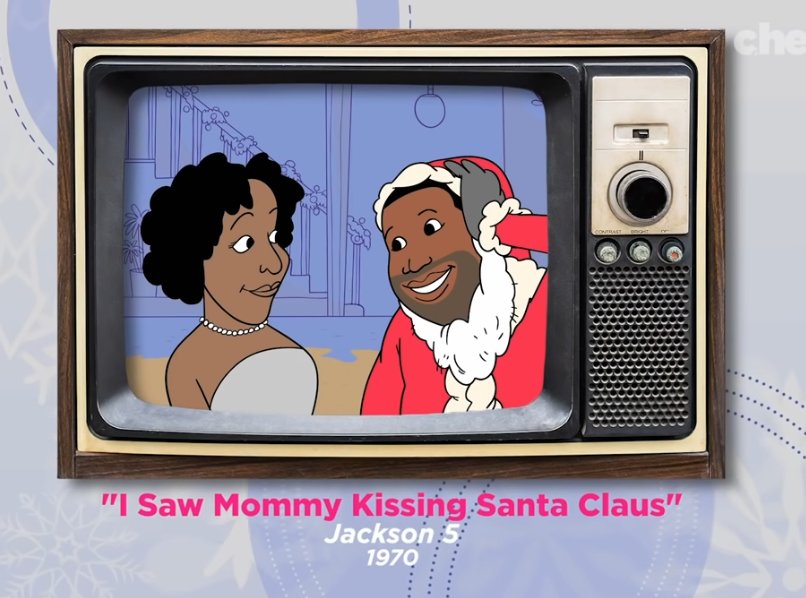It’s true: At Nogglestead, the lights will be up probably for another week, but the Christmas records get re-sorted to the bottom and back shelves until next year. By which time, I expect I will have gotten more. But that’s neither here nor there.
I didn’t get a chance to comment on this YouTube video, entitled “Cheddar Explains Why Almost All Christmas Music Is From the 1940s and 1950s”, which I saw on Neatorama:
Ah, well, Cheddar explains. Apparently, this is a YouTube channel that explores, explains, and in a brief ten minute clip condenses things for you.
It starts by comparing a Justin Bieber song to Nat King Cole singing “The Christmas Song” and says the only difference is time. Even though you can hear, quite clearly, that the orchestrations are completely different. The video goes on to interview a single expert on camera and circle a paragraph in a New York Times article and to say that, basically:
- The changing of the music industry from selling sheet music to selling records;
- Television;
- World War II;
- The commercialization of Christmas
All of which can sort of explain why the music of the 40s and 50s remains the stuff of our shared Christmas canon and more recent stuff does not.
Although the YouTube video says that sometimes a song breaks into the canon, like:

I guess Cheddar never heard of Spike Jones, does not own the Reader’s Digest Christmas Through The Years box set, or has not listened to DirecTV’s Christmas station, which plays the 1952 Spike Jones version of this song every night or so:
So, yeah, that comes from the 1950s, too, not a late-breaking 1970s addition to the canon. So, yeah, it looks like the 20-something on YouTube has an obvious gap in the knowledge she’s presenting. Say it ain’t so!
Off the top of my head, what other factors influence this affection for the old songs?
- World War II and troops away are pat, easy answers to the changes taking place in the 1940s and 1950s. Other changes across the country include electrification of rural areas and the actual transition from many rural people from carts and sleighs to cars. Not to mention urban population movements and migrations. So many of the most urban of people remembered sleighs, carts, and some of the trappings of simpler Christmases with family in the country–unlike our second-hand memories of the songs talking about them. These people in the 1940s and 1950s hearkened back to that time when they were young, and that’s how Christmas was.
- After the 1940s and the 1950s, the sound of popular music changed. They went from big band orchestrations and crooners to smaller arrangements with a guitar or two, drums, and a singer–rock and roll. The transition wasn’t immediate and simple, but if you flip through the music charts, you’ll see what I mean. So even when people released Christmas albums, the new kids didn’t generally sound like the things people had heard on their radios back in the day.
- Let’s talk about the content of the modern Christmas songs. All the way back to “Blue Christmas”, “This Christmas I Spend With You” (shudder), “Hey, Santa”, and the new canon “All I Want For Christmas Is You” are songs about the singer and the significant other. Not the singer and family. I cannot emphasize enough that the most resonant Christmases, er, resonate because they’re shared with family, not just the significant other (see also the film The Family Man, which is actually a Christmas movie but forgotten for some reason). The ones I remember most are from my youth that I spent with my parents and the ones that I have spent with my own children. So of course songs that play up the family will hit me and the Christmas music consumer more than ones about being young and in love (although, I hasten to say, I am still both). It’s kind of like how pop music (and country music to a lesser extent) has narrowed even in the most recent decades to targeting a very young demographic. So, yeah, these songs are not going to be favorites throughout the years.
- Also, the music industry has diversified greatly in the last decades; the popular songs on the radio (the music expert in the Cheddar video says radio drives popular music–really? In 2020? I am unconvinced) and the popular songs on the charts sell far fewer copies than popular music of the previous decades. So even if you write a “popular” song, a lot of people aren’t going to hear it, and it won’t reach a critical mass of “canon.” Not to mention that songwriters looking for a payday are no longer writing songs for the movies–many examples from the Cheddar video, such as “White Christmas” and “Have Yourself A Merry Little Christmas” were written for movies. Instead, they’re writing for the clubs and for the WAP fans. That’s where the money is. Not music a family can share, even though Christmas songs and Christmas records represent a good backlist item to have.
This blog post, too, is not really enough to explore in great detail all the forces that made those songs from that transitional time so resonant (that word again!) with the generation that experienced the transitions in the early part of the twentieth century and how their appreciation of those songs carried through the generations–their children (the Baby Boomers) and their children’s children (us) and onto our children (the people making YouTube videos as ways to share “knowledge”). But it recognizes the complexities the Cheddar video misses.
Now that I’ve finished this post, I can put the last of the Christmas music on the back shelf in my head, too.


